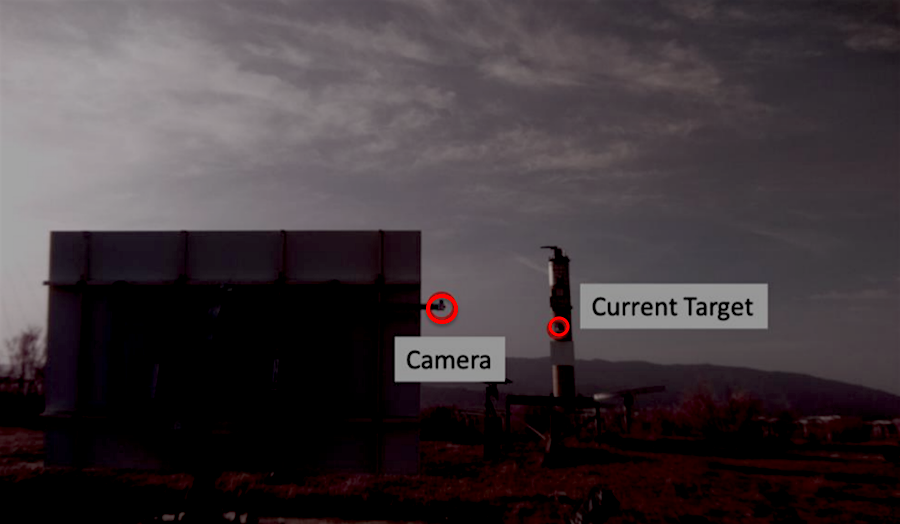
Artificial Vision Enables Solar Field Calibration Overnight: Aligning thousands of solar mirrors to reflect sunlight perfectly accurately onto the receiver on a solar tower gets a boost from artificial vision used in robotics, cutting commissioning time IMAGE@CENER
Researchers have developed a prototype for calibrating an entire solar field in a single night, shaving months off the current calibration system for large size Concentrated Solar Power (CSP) tower plants.
In tower CSP, an encircling solar field of thousands of heliostats (specialized mirrors) must continuously and precisely reflect concentrated beams from always-moving sunlight onto a tower receiver at distances ranging up to 1,600 meters. (How tower CSP works)
Their innovation is applying artificial visual digital systems to accurately “see” the target with pixel point accuracy, more precisely than human vision, and to do this they integrate digital cameras into each of the heliostats, making it possible to calibrate an entire solar field in just a few hours.
“With our visual calibrating system we can ensure tracking accuracy for the life of the plant, because we can calibrate every night,” said Marcelino Sanchez, who directs the solar thermal energy department at Spain’s Centro Nacional de Energías Renovables (CENER).
Sanchez presented their innovation at the 23rd SolarPACES Annual Conference in Chile in a presentation titled Scalable Heliostat Calibration System – How to calibrate your whole heliostat field in a single night. .
From hardware to software
All CSP plants use computerized systems to tell each of the thousands of individual heliostats in a solar field how to move, using servo motors that precisely control their motion. Each heliostat keeps its own reflected “sun” focused on the tower receiver as the sun moves across the sky and as the season changes.
However, in real world conditions, individual heliostats can become slightly misaligned as the surrounding terrain settles due to environmental conditions or distant earthquakes. Because heliostats must remain accurate at the milliradian (mrad) level to deliver the exact solar flux needed, neither to miss the mark, nor overheat the receiver, a great deal of research has gone into improving calibration accuracy.
A review in 2009 summarized earlier research. At SolarPACES2017, the research facilities presenting papers on heliostat calibration included, among others, PSA-CIEMAT, NREL, DLR, and Cyprus Institute. The use of cameras is not unusual. For example, BrightSource Energy uses pinhole cameras at the receiver to “see” the proper aiming of the heliostats.
“In principle heliostats don’t need recalibration; you calibrate them during installation,” said Sanchez. “But for all these small misalignments that may occur during the life time of the plant it is a clear advantage if you are able to check the precise positioning quickly and whenever desired.” With this innovative methodology it is possible to establish not only the position but the precise kinematic model of each and every heliostat under real working conditions.
Cutting solar field costs
“A goal for us was to try to reduce the cost of the tracking system that today is the most costly part of the heliostat system,” Sanchez explained. “So the idea here is to try to reduce the cost per square meter. So we moved cost from the hardware to the software system.” Heliostats wouldn’t need to be as sturdy and expensive.
With nightly recalibration possible through small cheaper mass-produced electronics, heliostats could become cheaper, with all the “brains” locked inside. Cristóbal Villasante, who heads renewable energy research on intelligent robotics and mechatronic systems at IK4-Tekniker partnered with Sanchez in developing the system.
“There are two main advantages of our system,” Villasante summed up.“One is that we can calibrate the system in an automatic way, so we can reduce commissioning time and plant costs. And two is if you can calibrate very often you can reduce the requirements for long-term stability so you don’t need such strong systems, which can be much cheaper and still reach the same accuracy, so we can use cheaper heliostats.”

Artificial vision enables accurate heliostat calibration IMAGE @CENER
What the scientists have innovated is the way they use a form of artificial vision for CSP solar field calibration.
Small infrared lights are positioned at various points around the solar field, and the camera orients its heliostat’s position in relation to the lights, “seen” digitally. This procedure provides the information needed for computing the real kinematic model of each and every heliostat.
“The sensors in the ordinary visible cameras are sensible for the near infrared. We use a filter and remove the visible part of the spectrum,” said Sanchez, who adds that they can detect the position with an error rate of 0.22 mrad. One mrad is 0.057° of a degree.
“Turning the light on and off makes it very easy to identify in which pixel we have it.”
Because they are now “seeing” through the camera they have precise knowledge of where the heliostat is pointing. The process saves computing time and resources; making the light target identification fast and easy.
“By knowing the positions of the heliostat motors and processing the captured images, the exact configuration of the heliostat, or what we call its “kinematic model” can be computed. Consequently, the heliostat is reprogrammed correcting any errors and ensuring that the sun is reflected accurately.”














































